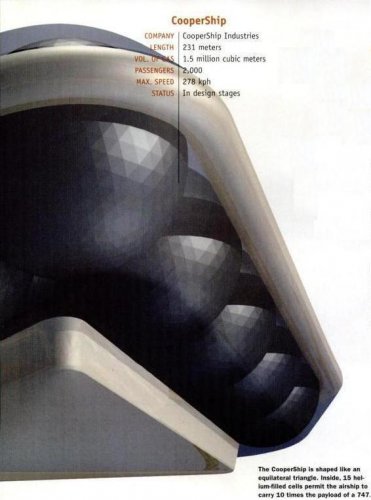FutureSpaceTourist
ACCESS: Top Secret
- Joined
- 10 March 2010
- Messages
- 590
- Reaction score
- 34
Coopership Industries was a company founded in 1996 to design and build (very) large rigid hull airships. The website at www.coopership.com appears to have disappeared in the early 2000s, but included this info on the proposed airship:
The attached picture comes from a January 2001 article in Popular Science on airships.
So why am I posting this in space projects? Well:
[quote author=http://www.bizjournals.com/dallas/stories/1998/07/13/story8.html]
NORTH DALLAS -- A Dallas businessman hopes to raise $5 million from investors and corporate sponsors to begin work launching a vehicle into space from an airship [my emphasis] with a rigid hull.
You read that right.
Dale Harris admits the idea sounds wacky. But many in the aerospace industry take it seriously.
So seriously, in fact, that Harris and his investment partners in the "Coopership" team have been approved for entry in the "X Prize" contest.
That international competition offers $10 million to the first privately financed international team that can successfully send humans into space.
Just for the record, rigid airships have an internal frame -- unlike the more common blimps that we see today.
The Coopership would be deltoid-shaped and look like a "flying wing," capable of traveling 150 miles an hour and able to carry 10 times the payload of a Boeing 747 jet. Fueled by a lifting gas that is lighter than air, such as hydrogen or helium, the Coopership will float -- but also fly like an aircraft.
The Georgia Institute of Technology's aerospace systems design laboratory has said it will help Harris and his team synthesize and analyze its concepts for the prize.
[...]
For the X Prize, Coopership Industries has proposed a two-stage process in which the airship carries a rocket-powered shuttle above the atmosphere, then launches it, thus avoiding atmospheric drag, said Nelles.
[/quote]
I don't know that anything ever happened beyond some vague proposal, but thought I'd post it here just in case someone remembers anything more about it.
Stand by for a quantum leap in air travel. It is called a CooperShip. It is as long as a football stadium (803’-10") along each of its three sides. It is as tall as a fourteen story building. It weighs nothing. Less than nothing. It floats.
This is what the Coopership can do:
- Carry 10 times the payload of a 747 a hundred times farther on the same amount of fuel.
- Carry 1,000 tons of cargo a distance of 12,000 miles, in all climates.
- Carry 2,000 passengers and 1,000 crew in more luxury and elegance than a cruise ship.
- Cruise at 150 knots, up to 250 knots, and hover in a stationary position at any altitude.
- Operate safely in unpressurized flight below 10,000 feet, with open windows.
- Float around the world without refueling.
The Coopership displaces 60 million cubic feet of air, air which weighs over 4,800 tons at sea level. Therefore, a thousand tons of buoyant lift is possible. In addition, aerodynamic lift further increases its efficiency. Cargo costs fifty cents per ton-mile aboard a 747, and about a nickel per ton-mile for a sea-going freighter. Aboard the CooperShip, it will be 2 1/2 cents per ton-mile.
The attached picture comes from a January 2001 article in Popular Science on airships.
So why am I posting this in space projects? Well:
[quote author=http://www.bizjournals.com/dallas/stories/1998/07/13/story8.html]
NORTH DALLAS -- A Dallas businessman hopes to raise $5 million from investors and corporate sponsors to begin work launching a vehicle into space from an airship [my emphasis] with a rigid hull.
You read that right.
Dale Harris admits the idea sounds wacky. But many in the aerospace industry take it seriously.
So seriously, in fact, that Harris and his investment partners in the "Coopership" team have been approved for entry in the "X Prize" contest.
That international competition offers $10 million to the first privately financed international team that can successfully send humans into space.
Just for the record, rigid airships have an internal frame -- unlike the more common blimps that we see today.
The Coopership would be deltoid-shaped and look like a "flying wing," capable of traveling 150 miles an hour and able to carry 10 times the payload of a Boeing 747 jet. Fueled by a lifting gas that is lighter than air, such as hydrogen or helium, the Coopership will float -- but also fly like an aircraft.
The Georgia Institute of Technology's aerospace systems design laboratory has said it will help Harris and his team synthesize and analyze its concepts for the prize.
[...]
For the X Prize, Coopership Industries has proposed a two-stage process in which the airship carries a rocket-powered shuttle above the atmosphere, then launches it, thus avoiding atmospheric drag, said Nelles.
[/quote]
I don't know that anything ever happened beyond some vague proposal, but thought I'd post it here just in case someone remembers anything more about it.

